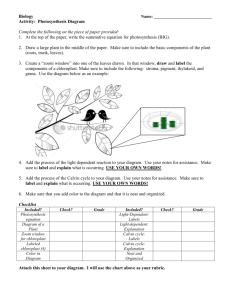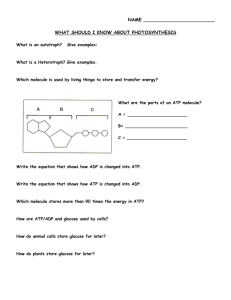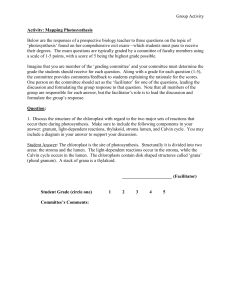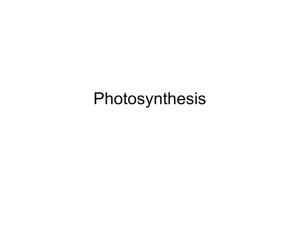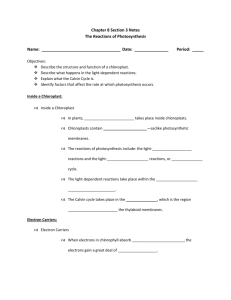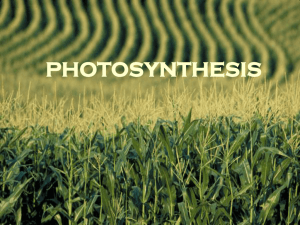Photosynthesis Wks.
advertisement
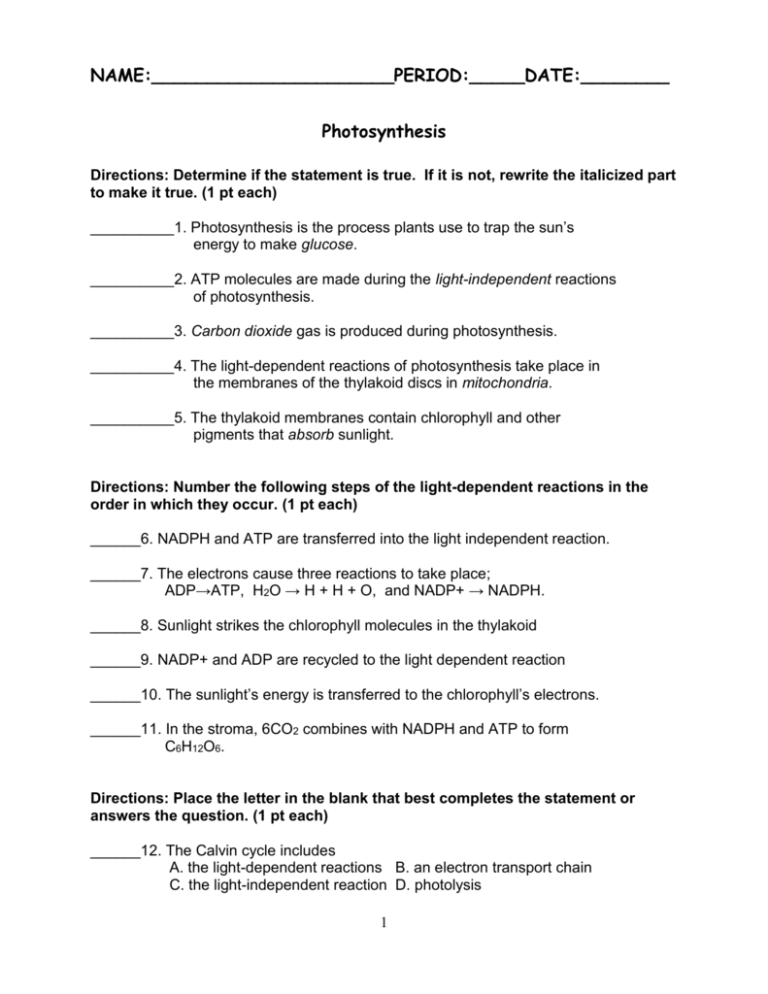
NAME:______________________PERIOD:_____DATE:________ Photosynthesis Directions: Determine if the statement is true. If it is not, rewrite the italicized part to make it true. (1 pt each) __________1. Photosynthesis is the process plants use to trap the sun’s energy to make glucose. __________2. ATP molecules are made during the light-independent reactions of photosynthesis. __________3. Carbon dioxide gas is produced during photosynthesis. __________4. The light-dependent reactions of photosynthesis take place in the membranes of the thylakoid discs in mitochondria. __________5. The thylakoid membranes contain chlorophyll and other pigments that absorb sunlight. Directions: Number the following steps of the light-dependent reactions in the order in which they occur. (1 pt each) ______6. NADPH and ATP are transferred into the light independent reaction. ______7. The electrons cause three reactions to take place; ADP→ATP, H2O → H + H + O, and NADP+ → NADPH. ______8. Sunlight strikes the chlorophyll molecules in the thylakoid ______9. NADP+ and ADP are recycled to the light dependent reaction ______10. The sunlight’s energy is transferred to the chlorophyll’s electrons. ______11. In the stroma, 6CO2 combines with NADPH and ATP to form C6H12O6. Directions: Place the letter in the blank that best completes the statement or answers the question. (1 pt each) ______12. The Calvin cycle includes A. the light-dependent reactions B. an electron transport chain C. the light-independent reaction D. photolysis 1 ______13. The Calvin cycle takes place in the A. mitochondria B. stroma C. nucleus D. thylakoid ______14. What product of the light-dependent reactions is used in the Calvin cycle? A. oxygen B. CO2 C. NADPH D. chlorophyll ______15. What gas is used in the first step of the Calvin cycle? A. oxygen B. CO2 C. hydrogen D. H2O ______16. What gas is released in the light-dependent reaction? A. oxygen B. CO2 C. hydrogen D. H2O ______17. Glucose is formed during the A. light-dependent reaction C. Calvin cycle B. electron transport chain D. photolysis ______18. How many rounds of the Calvin cycle are needed to form one glucose molecule? A. one B. six C. two D. three ______19. The main energy-trapping molecule in plants is A. chloroplast B. chlorophyll C. stroma D. carotenoids ______20. Energy from sunlight is trapped by chlorophyll located in the A. cytoplasm B. mitochondria C. stroma D. thylakoid ______21. Energy is released from ATP when the bond is broken between A. two phosphate groups B. adenine and ribose C. ribose and a phosphate group D. adenine and a phosphate group ______22. In the complete process of photosynthesis, the A. Calvin cycle yields CO2 B. light reactions release oxygen C. Calvin cycle breaks down H2O D. Light reactions produce NADP+ from NADPH + H+ ______23. Which of the following equations best represents photosynthesis? A. C + O2 + H2O → CO2 + HOH B. 6CO2 + 6H2O → C6H12O6 + 6O2 C. 6C + 6H2O → C6H12O6 D. C6H12O6 → 6CO2 + 6H2O 2 ______24. Leaves appear green because the green portion of the light that strikes them is A. changed to heat B. absorbed C. destroyed D. reflected ______25. The main energy source in plants is A. glucose B. ATP C. NADPH D. water Directions: Answer the following questions completely. 26. How do plants produce oxygen during photosynthesis? (1 pt) 27. Why do you see green when you look at a leaf on a tree? Why do you see other colors in the fall? (2 pts) 28. How do the light-dependent reactions of photosynthesis relate to the Calvin cycle? (2 pts) 29. Describe three factors that affect the rate at which photosynthesis occurs. (3 pts) 1. 2. 3. 30. Recall that energy flows and that nutrients cycle through the biosphere. How does the process of photosynthesis impact both the flow of energy and the cycling of nutrients? (If you forgot this, refer to ecology, chapter 3) (5 pts) 3



